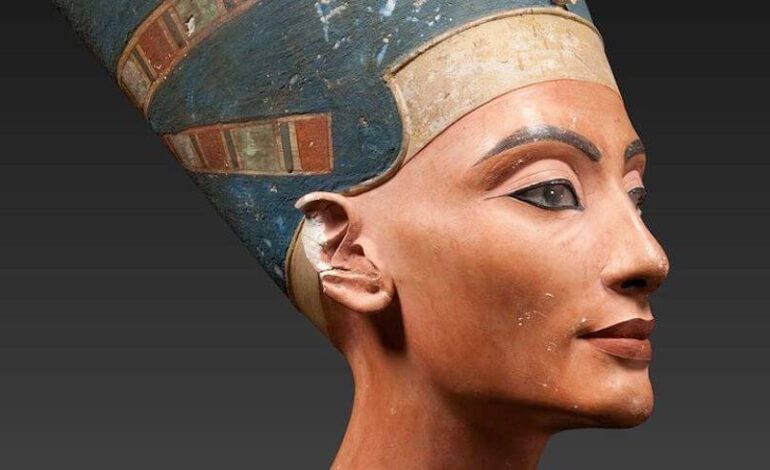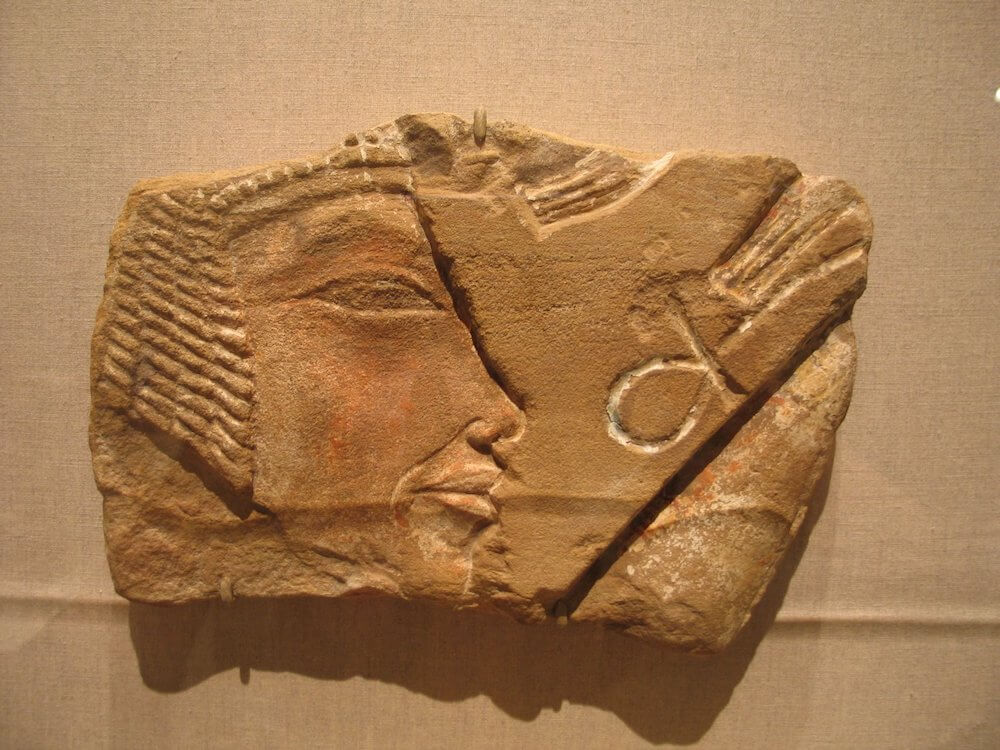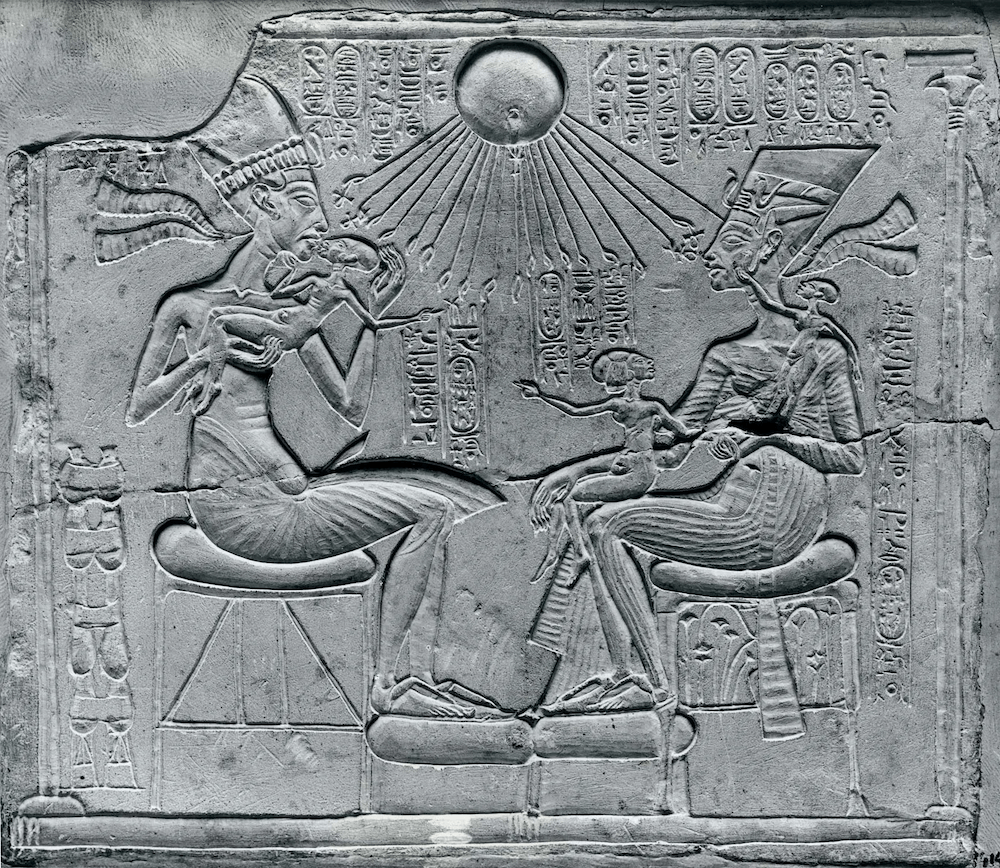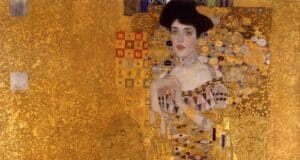What do we know about Nefertiti?

In the history of Ancient Egypt, we know about only a few female rulers. One of them was queen Nefertiti, who lived in the 14th century BC. She is a mysterious figure known for her beauty and for being a co-Pharo of Ancient Egypt. Nefertiti lived between circa 1370 and 1330 BC, married around the age of 15, gave birth to at least 6 children, and maybe was a sole ruler after her husband, Pharaon Amenhotep IV’s death.
Forty years of life 3000 years ago does not seem so much, right? Plus, there are more questions about her person than answers. So, why is she so famous?
In this piece, we’d like to explore what’s known about Nefertiti’s life, how she changed Egypt, and why people hated her.
When did Queen Nefertiti rule?
The story of Nefertiti is 3000 years old and thus lacks certainty. Even her provenance isn’t clear. Basically, the most evidence about Nefertiti’s life comes from images and inscriptions from steles found in the ancient city of Thebes, then in Amarna (otherwise known as Akhetaton). While these written sources give important information, they are scarce and often vague in description, which gives a lot of space for interpretations and speculations.

What does Nefertiti mean?
The name Nefertiti means “the beautiful one has come,” which might indicate her foreign origin, maybe from Mitanni (now North Syria). Another theory suggests that Nefertiti was a local and a sister of her future husband, Pharaon Amenhotep IV. This kind of alliance was typical for the royals, and not only in Egypt. Less ordinary was the couple’s collaboration in ruling the country.
The tombs and temples from Amenhotep IV’s reign revealed Nefertiti alongside her husband, sometimes even looking much like him. Moreover, some wall pictures show them holding their kids and even kissing. Images like these weren’t usual for the time, and this show of affection suggests that the couple was really in love. That said, Amenhotep had two wives – Nefertiti and Kiya. He is also believed to be the father of the famous Tutankhamun (probably with Kiya).
Why was Nefertiti important?
Nefertiti wasn’t simply a wife but a consort (a co-Pharaon) of Amenhotep. It meant that she took an active part in politics and religion. That said, their joint ruling of the country wasn’t successful regarding people’s love and devotion.

In c. 1348-1346 BC, Amenhotep decided to execute a religious reform. Before, the Egyptians worshiped different gods, much like Ancient Greeks with their Olympic gods. For example, Amon was the god of the Sun; Osiris was a god of the underworld, and Isis, was a goddess who could heal, mourn and set an example of motherhood. This polytheistic religion was a centuries-long tradition, but the new rulers decided to switch to monotheism. Amenhotep and Nefertiti chose one god – Aten, an embodiment of the Sun, as the one and only god. Usually, Aten was depicted as a solar disk with rays ending with hands.

This drastic shift came as a shock to the people, but there was more. The king and queen banned any depiction of the old gods and religious ceremonies of worshiping them. They ordered to destroy all the temples and shrines and built new ones instead. Finally, they found a new city of Akhetaton (now Tell el-Amarna), which became a religious center of Aton’s cult, and moved the capital there from Thebes.
In Ancient Egypt, religion and royal power were closely linked, so the reigning couple held central positions in religious practice.

What was Nefertiti known for?
Queen Nefertiti held an unparalleled power, indicated in her titles: The Great Wife of the King and The Lady of the Two Lands. Moreover, Nefertiti was proclaimed the high priestess and “worked” as a medium between people and god Aten. Before, the priests held almost as much power as the pharaoh, but the reform fully restored the authority of the rulers. In other words, Nefertiti substituted all priests and thus fired them from their jobs. Soon, the royals proclaimed themselves gods and demanded to worship them accordingly. Amenhotep changed his name to Akhenaten, while Nefertiti took the name of Nefernefruaten, which means “beautiful in beauty is Aten.”

The country spent countless funds to implement the reform, tore down temples, and built new ones exclusively for Aten. They started headhunting of old-believers, trying to erase old religious practices. The elite resisted these changes, and people hated Pharo and his wife. In 1336 BC or 1334 BC, Amenhotep died, and the previous order was soon restituted. From then on, we have nearly zero evidence of Nefertiti’s life. Many archeologists suggested that Nefertiti died earlier and thus disappeared from history. But in 2012, the researchers found a limestone inscription mentioning Nefertiti’s name. This finding shows that Nefertiti was still alive near the end of Pharo’s rule.
Other theories suggest that Nefertiti did reign solo under different names. For instance, a leading Egyptologist, Dr. Zahi Hawass, believes that Nefertiti ruled Egypt for three years after Amenhotep’s death under the name of Smenkhkare. There was already a precedent when a female disguised under a man’s personality to get power. However, there needs to be more evidence to support this theory. All in all, Nefertiti disappeared from history for a good 2200 years.
Why is Nefertiti still famous?
The year 1912. The German archeological team, on the head with Ludwig Borchardt, discovered a bust of Nefertiti in the city of Tell el-Amarna (originally Akhetaton). The 19 in (48 cm) high figure was created in the limestone around 1345 BC by the sculptor Thutmose. Apart from being valuable by itself, this artifact confirmed those legends of Nefertiti’s beauty. A slender neck, prominent cheekbones, and mesmerizing gaze made Nefertiti an icon of female beauty and one of the most celebrated Egyptian Queens. There is one stela found in Amarna (Akhetaton) with an inscribed passage proclaiming her beauty: “The leading woman of all the nobles, great in the palace, perfect of appearance, beautiful in the double plume…”

The bust of Nefertiti was shipped to Germany. When in 1930-es Egypt requested the return of the artifact, Hitler supposedly said: “I will never relinquish the head of the Queen.” During World War 2, the bust was hidden in a salt mine.
The bust depicts Nefertiti without one eye, which has led to numerous speculations about her authentic image. One theory suggests that Nefertiti had a natural fold of skin over her eye; the second says that she may have lost her eye due to some infection; the third implies that a missing eye may have been an insult to the queen for her drastic politics. That said, Ludwig Borchardt, who found the bust, supposed that the eye’s iris was lost during the excavation.

The bust of Nefertiti is exposed in the Neues Museum in Berlin. Every year it attracts around 500 000 visitors.
In 2009, the celebrated beauty of Nefertiti was questioned. The CT scans revealed the second face underneath the surface. It has less smooth skin, a bump on the nose, and even visible lines around the mouth. Some Egyptologists suggest that either queen Nefertiti or her husband wasn’t satisfied with the result and requested the artist to “retouch” the face and make it more refined.

Nefertiti is more than just a beauty icon of early civilization. She may also be a rare example of a woman in power in the ancient world. But there are more questions about Nefertiti than facts, which raise even more interest in her persona. As the queen’s final resting place remains unknown, archeologists have already said that it would be the greatest finding of all recent years.
In September 2022, the team of archeologists announced that they might have found Nefertiti’s tomb in the hidden area of King Tut’s burial chamber. Still, there is a lot of research and DNA tests waiting ahead. We look forward to seeing the finding confirmed and will update the article afterward.
Nefertiti’s story is just one example of how powerful figures shape history. See how Napoleon redefined leadership in Europe, why monarchies continue to exist today, or explore the darker turn of power in Hitler’s Germany.













